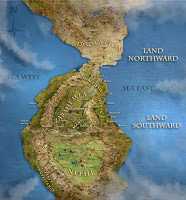But that’s not the same as saying the historicity of the Book of Mormon–meaning, it’s status as an authentic history of real people–doesn’t matter at all.
Without the divine authenticity of the Book of Mormon, would it be any more relevant than inspirational sermons based on the Bible?
Early Church leaders and authors, including Joseph Smith and Oliver Cowdery, recognized the importance of historicity. Responding to claims the book was fiction, they wrote a series of eight historical essays–the original Gospel Topics essays, except they were signed by Oliver and personally endorsed by Joseph–that set forth facts to counter the claims of the critics.
One of those facts, cited in Letter VII, was the New York setting for the Hill Cumorah, described in Mormon 6:6.
_____
 |
| BYU Fantasy map of the Book of Mormon |
Today, many people appear to have abandoned that approach.
Instead of teaching the New York Cumorah as fact, in our day employees at CES and BYU teach their students about the Book of Mormon using M2C-inspired, computer-generated fantasy maps that are tantamount to teaching the Book of Mormon is fiction.
The New York Cumorah doesn’t answer questions about the rest of Book of Mormon geography–there are innumerable possibilities because there are innumerable ancient sites about which we don’t have much information. The problem isn’t figuring out where the Book of Mormon fits; the problem is choosing among the many alternatives where it does fit.
The rest of the geography doesn’t matter only because we have a known, real-world “pin in the map” we can rely upon to establish historicity.
Unlike the fantasy maps, the New York Cumorah firmly places the text in the real world–just as prophets and apostles have consistently and persistently taught from the earliest days of the Church.
M2C is devastating because it removes the one sure connection among (i) the Book of Mormon, (ii) the real world, and (iii) the teachings of the prophets.
The M2C intellectuals have replaced certitude and confidence with their self-serving ambiguity and uncertainty. This is the fulfillment of the warning of Joseph Fielding Smith, when he said of M2C that “Because of this theory some members of the Church have become confused and greatly disturbed in their faith in the Book of Mormon.”
_____
I’m curious how we can expect to convince the world that Jesus is the Christ when our own scholars–and all their students, including missionaries–resort to a fantasy map to explain the text.
Imagine the situation in reverse. This is a sequence that occurs daily, around the world, in one form or another.
Missionaries knock on your door and tell you about an inspirational, Christ-centered book that contains a thousand years of history of a branch of the House of Israel. You’re surprised because you’ve never heard about this before, so you ask, “Who were these people? Where did this happen?”
The missionaries reply, “We have no idea, except that it was somewhere in the Americas.”
If you’re not so stunned at this response that you thank them politely and excuse yourself (feeling sorry for the nice young people), you might take a copy of the book and look through it.
After they leave you get on the Internet and in just a few minutes discover that the missionaries’ own Church leaders have taught that an important place in the book–the Hill Cumorah–was in western New York, at the same hill where Joseph found the plates.
That makes sense. You wonder why the missionaries didn’t just tell you that in the first place.
When the missionaries return, you ask them about this.
You: “I read on the Internet that your Church leaders said something called the Hill Cumorah is in New York. It’s supposed to be an important place in your Book of Mormon.”
Missionary #1: “Yes, it’s an important place, but we don’t think it was in New York, after all.”
Missionary #2: “Well, some people think it’s in New York, but most of us think it was in Mexico. That’s what all our scholars say. But it could be anywhere.”
You: “Hold on. I just read that your own leaders said it was in New York.”
Missionary #1: “They were probably wrong.”
Missionary #2. “The thing is, we don’t know. But we promise that if you’ll read the book, you’ll know it’s true.”
And just like that, the missionaries dissuade yet another interested person from further inquiries.
_____
Here’s something to consider, from Elder Spencer W. Kimball:
“I’ve known people who have been promised in their patriarchal blessings that they would live to see the temple built and some of them are dying and haven’t seen the temple built. Do you know why? In my estimation, the Lord’s time table is directed a good deal by us. We speed up the clock or we slow the hands down and we turn them back by our activities or our procrastinations. And do you know why I think people who are actually promised that they would live to see the temple built are dying before the completion of the temple? Because we haven’t converted the Indians in large enough numbers; never shall we go to Jackson County until we have converted and brought into this church great numbers of Lamanites. Now you just as well set that down as a basic fact.”–From a copy of the December 1963 talk obtained from President Kimball’s secretary as quoted in Book of Mormon Student Manual (Salt Lake City: The Church of Jesus Christ of Latter-day Saints, 2nd ed., 1981), 427-28
Source: Book of Mormon Wars

One thought on “Historicity is key”
I love this blog!
Comments are closed.